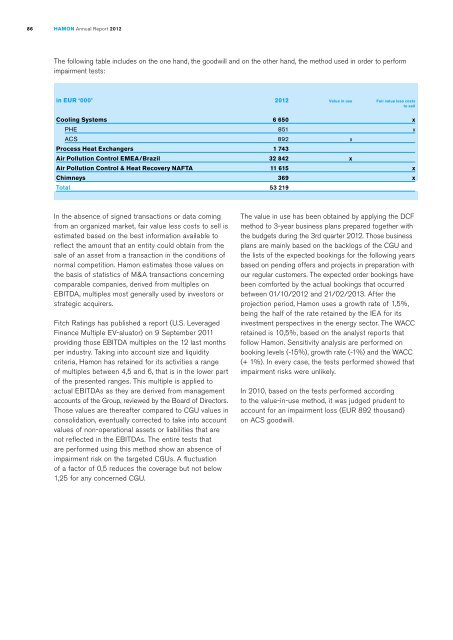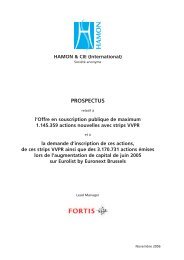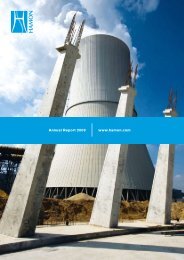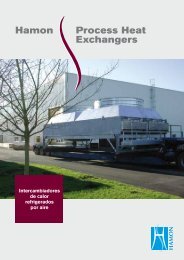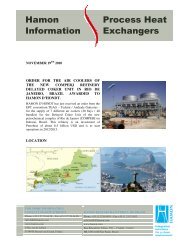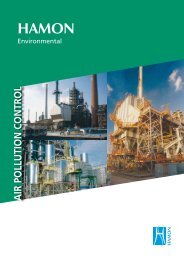Download PDF version English (3237KB) - Hamon
Download PDF version English (3237KB) - Hamon
Download PDF version English (3237KB) - Hamon
Create successful ePaper yourself
Turn your PDF publications into a flip-book with our unique Google optimized e-Paper software.
86<br />
<strong>Hamon</strong> Annual Report 2012<br />
The following table includes on the one hand, the goodwill and on the other hand, the method used in order to perform<br />
impairment tests:<br />
in EUR ‘000’<br />
Cooling Systems<br />
PHE<br />
ACS<br />
Process Heat Exchangers<br />
Air Pollution Control EMEA/Brazil<br />
Air Pollution Control & Heat Recovery NAFTA<br />
Chimneys<br />
Total<br />
2012 Value in use Fair value less costs<br />
to sell<br />
6 650 x<br />
851 x<br />
892 x<br />
1 743<br />
32 842 x<br />
11 615 x<br />
369 x<br />
53 219<br />
In the absence of signed transactions or data coming<br />
from an organized market, fair value less costs to sell is<br />
estimated based on the best information available to<br />
reflect the amount that an entity could obtain from the<br />
sale of an asset from a transaction in the conditions of<br />
normal competition. <strong>Hamon</strong> estimates those values on<br />
the basis of statistics of M&A transactions concerning<br />
comparable companies, derived from multiples on<br />
EBITDA, multiples most generally used by investors or<br />
strategic acquirers.<br />
Fitch Ratings has published a report (U.S. Leveraged<br />
Finance Multiple EV-aluator) on 9 September 2011<br />
providing those EBITDA multiples on the 12 last months<br />
per industry. Taking into account size and liquidity<br />
criteria, <strong>Hamon</strong> has retained for its activities a range<br />
of multiples between 4,5 and 6, that is in the lower part<br />
of the presented ranges. This multiple is applied to<br />
actual EBITDAs as they are derived from management<br />
accounts of the Group, reviewed by the Board of Directors.<br />
Those values are thereafter compared to CGU values in<br />
consolidation, eventually corrected to take into account<br />
values of non-operational assets or liabilities that are<br />
not reflected in the EBITDAs. The entire tests that<br />
are performed using this method show an absence of<br />
impairment risk on the targeted CGUs. A fluctuation<br />
of a factor of 0,5 reduces the coverage but not below<br />
1,25 for any concerned CGU.<br />
The value in use has been obtained by applying the DCF<br />
method to 3-year business plans prepared together with<br />
the budgets during the 3rd quarter 2012. Those business<br />
plans are mainly based on the backlogs of the CGU and<br />
the lists of the expected bookings for the following years<br />
based on pending offers and projects in preparation with<br />
our regular customers. The expected order bookings have<br />
been comforted by the actual bookings that occurred<br />
between 01/10/2012 and 21/02/2013. After the<br />
projection period, <strong>Hamon</strong> uses a growth rate of 1,5%,<br />
being the half of the rate retained by the IEA for its<br />
investment perspectives in the energy sector. The WACC<br />
retained is 10,5%, based on the analyst reports that<br />
follow <strong>Hamon</strong>. Sensitivity analysis are performed on<br />
booking levels (-15%), growth rate (-1%) and the WACC<br />
(+ 1%). In every case, the tests performed showed that<br />
impairment risks were unlikely.<br />
In 2010, based on the tests performed according<br />
to the value-in-use method, it was judged prudent to<br />
account for an impairment loss (EUR 892 thousand)<br />
on ACS goodwill.


